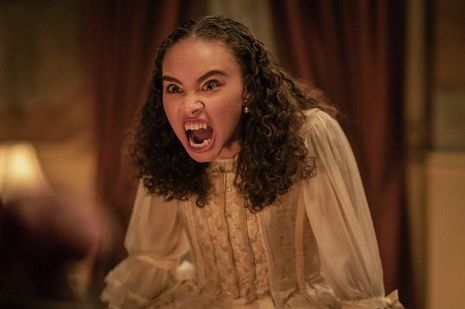Interview with a Vampire: a case study in clever costume design
Matilda Barker argues that Interview with a Vampire’s costuming is a lesson in aesthetic and narrative harmony

AMC’s Interview with the Vampire masterfully dramatises and adapts Anne Rice’s infamous Gothic novels series, The Vampire Chronicles, for a 2020s TV audience. It follows the story of Louis de Pointe du Lac (Jacob Anderson), a gay Black man from 1910s New Orleans transformed into a reluctant vampire. His history spans continents, and much of the 20th century, and is framed by his own narration in the eponymous 2020 interview. Key to this history are his vampiric maker and companion, Lestat de Lioncourt (Sam Reid), and their eternally juvenile daughter Claudia (Bailey Bass, later Delainey Hayles).
The show resists any attempt to separate the ageless vampire characters from the shifting contexts they inhabit. This manifests within the script –but also in the work of costume designer Carol Cutshall. It is a case study in the often undervalued formative role that costume design plays. This element exists both inside and outside the world of the show. Who is choosing these clothes? Why are they choosing them?
“It is a case study in the often undervalued formative role that costume design plays”
There is no character for whom this is more clear than Claudia, defined by her eternal status as physically 14 years old, even as her mind ages. Born in 1903, turned in 1917, she comes mentally of age across a period of huge change for women, reflected in the developments in women’s fashions. Her costuming is a brilliant example of how costume designers, alongside writers, can utilise period influence and implications.
But how is this achieved beyond merely reflecting what was in vogue in a particular period? Cutshall chooses specific aspects of period fashion to highlight. For example, in the darkly idyllic years of familial life after Claudia becomes a vampire, she is sent out for her first hunt in a blue and white sailor suit, red bows neatly holding up her hair. In an interview with AMC Talk, Cutshall notes her inspiration in classic children’s wear, as well as Edwardian dolls – inspirations which implicitly emphasises Claudia’s lack of autonomy. This is comedically lampshaded in an exchange between her fathers (‘I’m not sure about the skirt…’ ‘It’s chiffon, it has movement! ’). Movement or not, the silhouettes of her outfits in this period all reflect this straight lined, drop waisted shape – a classic image of the 1920s. This silhouette fits the body Claudia naturally has, designed to create a slight and androgynous shape. The style is effortlessly suited to her, just as her mind currently matches her body.
It is a shift in focus from the childlike or androgynous aspects of 1920s fashion which marks a change in this internal relationship. As Claudia mentally reaches 18, Cutshall focuses on the social implications of 1920s fashion – the way the decade’s loose styles indicate the rise of a ‘more radical female life’. In an almost parodic coming of age scene, Claudia rushes down the stairs in a new outfit of furs, cloche hat and red lipstick, a mature shift in her styling explicitly chosen independently to express her new sexual awakening. Her fathers look on fondly, their new separation from her styling emphasised with another quip (‘I don’t remember buying that? ’).
As she exits her home and enters the world alone, the costume design creates a mirror for the audience of Claudia’s own realisations of the growing dissonance between her mind and body – what she chooses to wear is now observed to be unfitting, odd, and ridiculous for her body.
Cutshall continues to utilise the context behind fashion and women’s contemporary position to reflect Claudia’s. Claudia is not a victim of misogyny in quite the way that an adult non-vampiric woman of the period is. However, when she returns home from her ‘university years’ (lurking in libraries, devouring people and books alike, essentially what I assume happens in the UL towers), Cutshall describes how she wished to show Claudia, now mentally in her 30s, becoming a ‘little businesswoman’. She dresses in lounge suits as she takes up the mantle of running the household, one father vulnerable and the other exiled for his abuse.
“The use of costume design within the series illuminates and visualises the conflicts of perception, control, and interiority”
Upon the reassembly of their household in the 1940s, she demands she take her place as a sister to the male vampires, rather than a daughter. This assertion of equality, and her simultaneous emulation of and challenge to Lestat’s patriarchal role in their family, is mirrored in her wardrobe. Her trousers, shoulder pads, and sharply collared blazers stylistically parallel the contemporary origins of this style, with women’s assertion of presence and equality in the workplace. It creates an even sharper contrast to her final costume of the season, a daddys-and-me French Mardi Gras outfit of Lestat’s design and era. It is a falsified pantomime of the familial harmony of the earlier episodes, where the fashion fit the era, and Claudia was happy to be styled into the first American Girl doll with a body count.
The show further weaves the costume design into the fabric of the show in the second season, in their adaptation of Claudia’s companion Madeleine from a dollmaker to a dress-maker. As Claudia enters post-war Paris, Cutshall, speaking to TV Guide, cites her inspiration in Christian Dior’s emerging ‘New Look’, a silhouette which emphasised the adult female figure. Cutshall suggests that this change of silhouette works as a mirror for Claudia in this period, where she is ‘trying to find a new form for herself’, and in which she feels she is ‘being seen as a woman for the first time’. By depicting on screen the creation process of Claudia’s dresses by Madeleine, adult dresses made to fit her, the show recalls the role that clothing has symbolically held in mitigating or exposing the dissonance between her mind and body. Claudia successfully finding a ‘new form for herself’ is inseparable from her search for someone who understands her mind enough to create this.
Costuming is also used as an even starker symbol of the limits of this progress. At this moment Claudia feels she has been accepted by the vampiric community she always sought, in the form of a theatre troupe of vampires, she is presented with her first costume for the stage. She is to play ‘Baby Lou Lou’, a caricatured infant character. She is handed a dress Cutshall describes as a like an ‘illustration’ from a children’s storybook, with a high waistband and huge skirt which mock the adult silhouettes she has been wearing. The brutal separation from autonomy and era, a mirror to all that her Mardi Gras outfit represented in New Orleans, is the ultimate symbol of inescapable control and betrayal.
The use of costume design within the series illuminates and visualises the conflicts of perception, control, and interiority which underlie this character. This not a function limited to the portrayal of perpetually teenage vampires, but demonstrates the possibilities inherent in the almost metatheatrical nature of costume design. By placing the dressing process on screen, costuming becomes a collaboration between the costume designer and the characters (or, less poetically, the writers), as well as the audience’s own perceptions of an era.
 Features / Should I stay or should I go? Cambridge students and alumni reflect on how their memories stay with them15 December 2025
Features / Should I stay or should I go? Cambridge students and alumni reflect on how their memories stay with them15 December 2025 News / Cambridge study finds students learn better with notes than AI13 December 2025
News / Cambridge study finds students learn better with notes than AI13 December 2025 News / Uni Scout and Guide Club affirms trans inclusion 12 December 2025
News / Uni Scout and Guide Club affirms trans inclusion 12 December 2025 Comment / The magic of an eight-week term15 December 2025
Comment / The magic of an eight-week term15 December 2025 News / Cambridge Vet School gets lifeline year to stay accredited28 November 2025
News / Cambridge Vet School gets lifeline year to stay accredited28 November 2025









